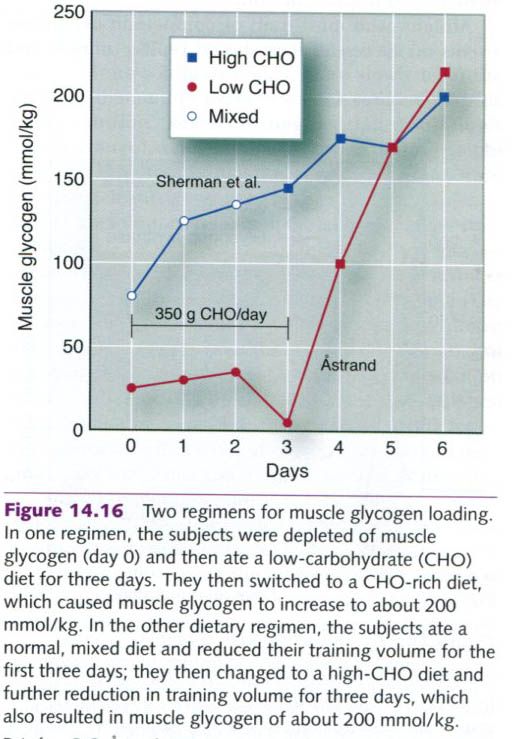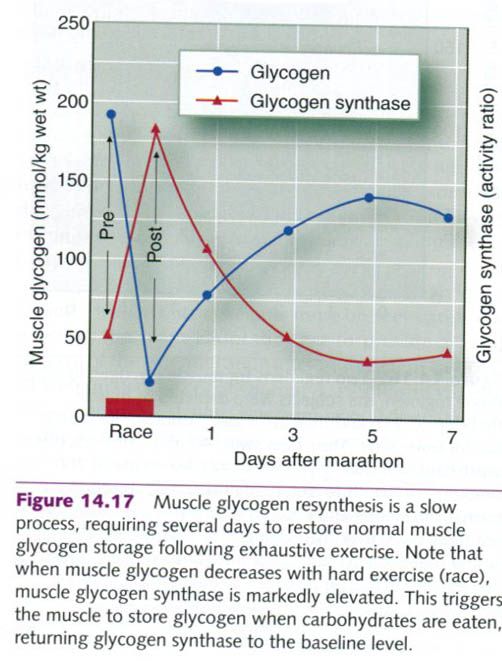In an effort to eat a healthy diet and increase
their carbohydrate intake, many athletes have adopted vegetarianism. Vegans are
strict vegetarians who eat only food from plant sources. Lactovegeterians also
consume dairy products. Ovovegeterians add eggs to their vegetable diets, and
lacto-ovovegeterians eat plant foods, dairy products, and eggs.
Can athletes perform well on a vegetarian diet?
Athletes who are strict vegans must be very careful in selecting the plant foods
they eat to provide a good balance of the essential amino acids, sufficient
calories, and adequate sources of vitamin A, riboflavin, vitamin B12, vitamin D, calcium, zync,
and iron. Adequate iron intake is of particular concern in
female vegetarian athletes because of the lower bioavailability of iron in
plant-based diets and because of women’s greater risk for anemia and low iron
stores. Some professional athletes have noted significant deterioration in
athletic performance after switching to strict vegetarian diets. The problem
usually is traced to unwise selection of foods. Including milk and eggs in the
diet decreases the risk of nutritional deficiencies. Anyone contemplating
switching to a vegetarian diet should either read authoritative material on the
subject written by qualified nutritionists or consult a registered dietitian or
sport nutritionist.
Precompetition meal
For years, many athletes have eaten the
traditional steak dinner several hours before competition. This practice might
have originated from the early belief that muscle consumes itself to fuel its
own activity and that steak would provide the necessary protein to counteract this loss. But we know that the steak is
probably the worst food an athlete could eat before competing. Steak contains a
relatively high percentage of fat,
which requires several hours for full digestion. During competition, this would
cause the digestive system to compete with the muscles for the available blood supply. Also, nervous tension is
typically high before a big competition, so even the choicest steak cannot
truly be enjoyed at this time. The steak would be more satisfying and less
likely to disturb performance if the athlete were to eat it either the night
before or after the competition. But if steak is out, what should the athlete
eat before competing?
Although the meal ingested a few hours before
competition might contribute little to muscle glycogen stores, it can ensure a
normal blood glucose level and
prevent hunger. This meal should contain only about 200 to 500 kcal and consist
mostly of carbohydrate foods that are easily digested. Foods such as cereal,
milk, juice, and toast are digested rather quickly and won’t leave the athlete
feeling full during competition. In general, this meal should be consumed at
least 2h before competition. The rates at which food is digested and nutrients
are absorbed into the body are quite individual, so timing the precompetition
meal might depend on prior experience. In one study of endurance cyclists, a
prolonged cycling exercise trial to exhaustion at 70% of the subject’s VO2max
was performed under two different conditions, with 14 days between trials: 100g
of carbohydrate breakfast fed 3h
before exercise(Fed) and no feeding before exercise(Fasted). Subjects tested under
the Fed condition exercised 136 min before reaching exhaustion compared with
109 min in the fasted trial, indicating the importance of the precompetition
meal.
A liquid precompetition meal might be less
likely to result in nervous digestion, nausea, vomiting, and abdominal cramps.
Such feedings are commercially available and generally have been found useful
both before and between events. Finding time for athletes to eat is often
difficult when they must perform in multiple preliminary and final events.
Under these circumstances, a liquid feeding that is low in fat and high in carbohydrate
might be only solution.
Muscle glycogen replacement and loading
Earlier was established that different diets
can markedly influence muscle glycogen stores and that endurance performance
depends largely on these stores. The theory is that the greater the amount of
glycogen stored, the better the potential endurance performance because fatique will be delayed. Thus, an
athlete’s goal is to begin an exercise bout or competition with as much stored
glycogen as possible.
On the basis of muscle biopsy studies conducted
in the mid-1960s, Astrand proposed a plan to help runners store the maximum
amount of glycogen. This process is
known as glycogen or carbohydrate loading. According to Astrand’s regimen,
athletes should prepare for an aerobic endurance competition by completing an
exhaustive training bout seven days before the event. For the next three days,
they should eat fat and protein almost exclusively to deprive
the muscles of carbohydrate, which increases the activity of glycogen synthase,
an enzyme responsible for glycogen synthesis and storage. Athletes should then
eat a carbohydrate-rich diet for the remaining three days before the event.
Because glycogen synthase activity is increased, increased carbohydrate intake results in greater muscle glycogen storage.
Training intensity and volume during this six-day period should be markedly
reduced to prevent additional muscle glycogen depletion, thus maximizing liver and muscle glycogen reserves. Originally,
an additional intense training bout was performed four days prior to
competition.
This regimen has been shown to elevate muscle
glycogen stores to twice the normal level, but it is somewhat impractical for
most highly trained competitors. During the three days of low carbohydrate intake, athletes generally find training difficult. They are also often
irritable and unable to perform mental tasks, and they typically show signs of
low blood sugar, such as muscle weakness and disorientation. In addition,
the exhaustive depletion bouts of exercise performed seven days before the
competition have little training value and can impair glycogen storage rather
than enhance it. This depletion exercise also exposes athletes to possible
injury or overtraining.
Considering these limitations, many proposed
that the depletion exercise and the low carbohydrate aspects of Astrand’s
regimen be eliminated. Instead, according to Sherman and colleagues, the
athlete should simply reduce training intensity a week before competition and
eat a normal, mixed diet containing 55% of the calories from the carbohydrate until three days before
competition. For these days, training should be reduced to a daily warm-up of
10 to 15 min of activity and accompanied by a carbohydrate-rich diet. Following
this plan, as seen in the figure below, glycogen
will be elevated to nearly 200 mmol/kg of muscle, the same level attained with
Astrand’s regimen, and the athlete will be better rested for competition.
It is possible to increase carbohydrate stores rapidly after even a very short
near-maximal-intensity bout of exercise. In a study of seven endurance
athletes, scientists found that cycling for 150s at 130% of VO2max followed by 30s of
all-out cycling and 24h of high-carbohydrate intake was sufficient to nearly
double muscle glycogen stores in just
one day.
Diet is also important in preparing the liver
for the demands of endurance exercise. Liver glycogen stores decrease rapidly
when a person is deprived of carbohydrates
for only 24h, even when at rest. With only 1h of strenuous exercise, liver
glycogen decreased by 55%. Thus, hard training combined with a low-carbohydrate
diet can empty the liver glycogen stores. A single carbohydrate meal, however, quickly restores liver glycogen to
normal. Clearly, a carbohydrate-rich diet in the days preceding competition
will maximize the liver glycogen reserve and minimize the risk of hypoglycemia
during the event.
Water is stored in the body at a rate of about
2.6g of water with each gram of glycogen. Consequently, an increase or decrease
in muscle and liver glycogen generally produces a change in the body weight of
from 0.5 to 1.4kg(1-3 lb). Some scientists have proposed monitoring of changes
in muscle and liver glycogen stores via recording the athlete’s early morning
weight immediately after rising – after emptying the bladder but before eating
breakfast. A sudden decrease in weight might reflect a failure to replace glycogen, a deficit in body water, or both.
Athletes who must train or compete in
exhaustive events on successive days should replace muscle and liver glycogen stores as rapidly as possible. Although
liver glycogen can be depleted totally after 2h of exercise at 70% VO2max, it is replenished
within a few hours when a carbohydrate-rich meal is consumed. Muscle glycogen
resynthesis, on the other hand, is a slower process, taking several days to
return to normal after an exhaustive process bout such as the marathon(see
figure below). Studies in the late 1980s revealed that muscle glycogen resynthesis was most rapid when individuals were fed at least 50g(about 0.7g/kg
body weight) of glucose every 2h after the exercise. Feeding subjects more than
this amount did not appear to accelerate the replacement of muscle glycogen.
During the first 2h after exercise, the rate of muscle glycogen resynthesis is
much higher than later in recovery. Thus, an athlete recovering from an
exhaustive endurance event should ingest sufficient carbohydrate as soon after exercise as a practical. Adding protein and amino acids to the carbohydrate
ingested during the recovery period enhances muscle glycogen resynthesis above
that achieved with carbohydrate
alone.











0 коментара:
Постави коментар